Letters from Arthur Seaforth Blackburn to his family, 1941 - Part 17
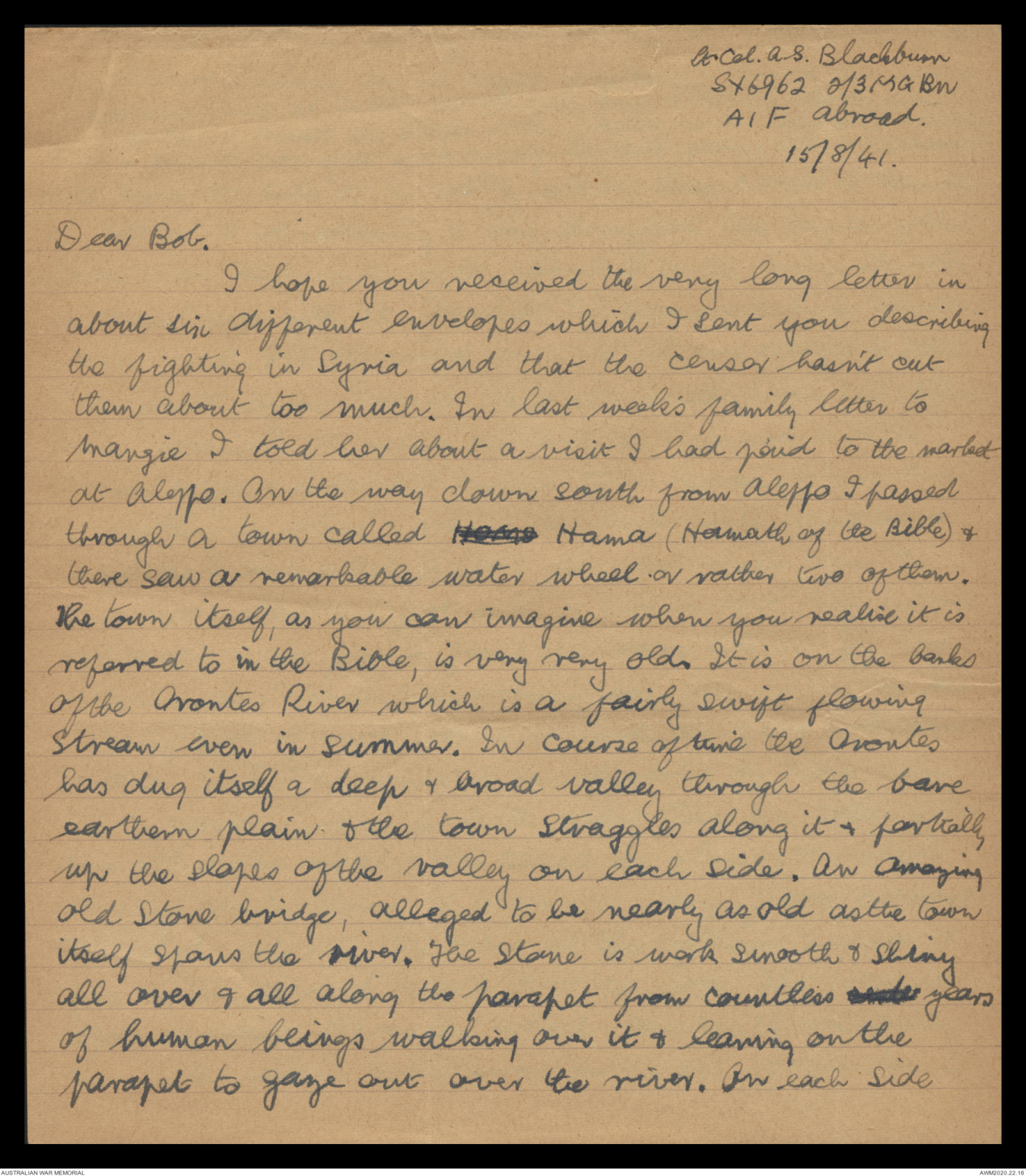
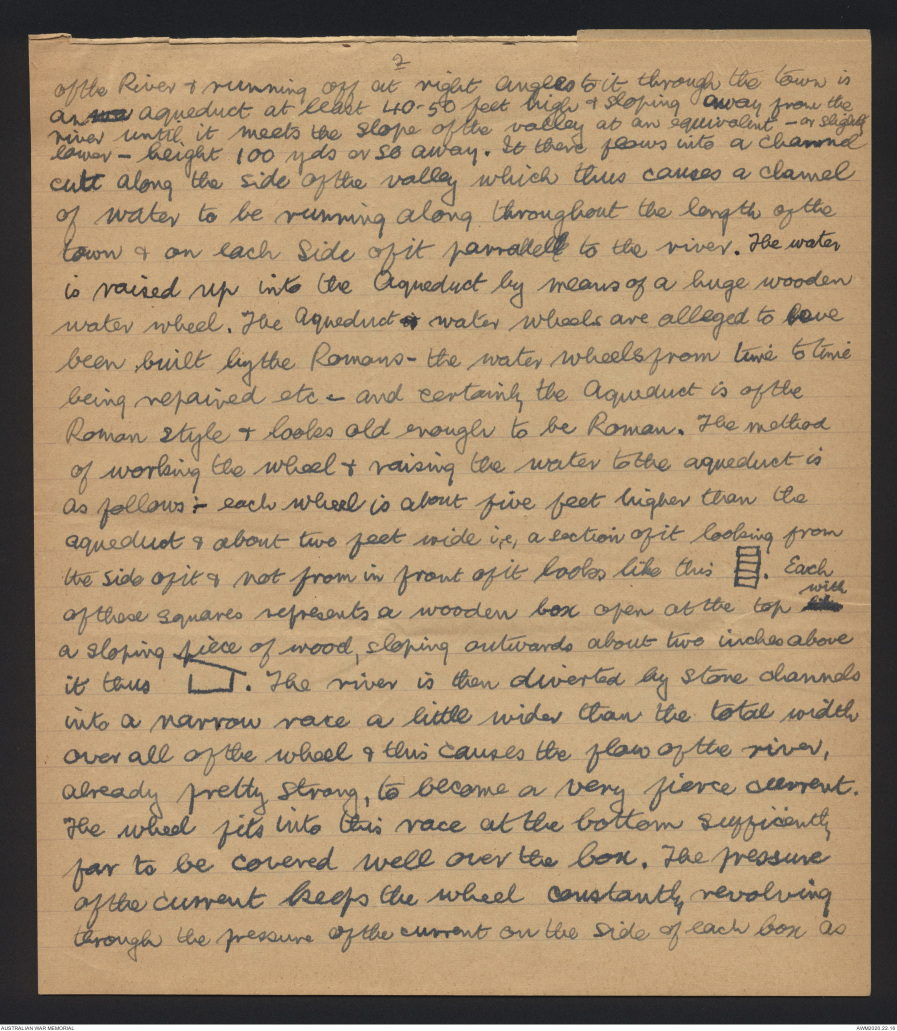
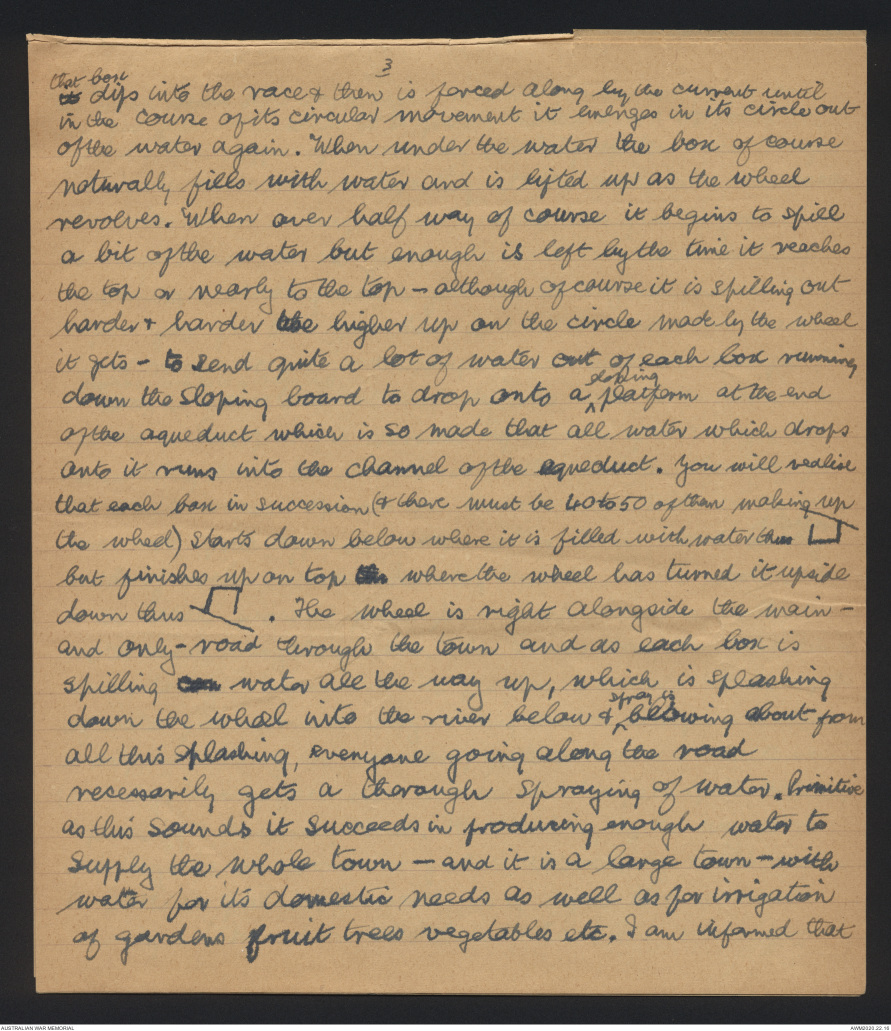
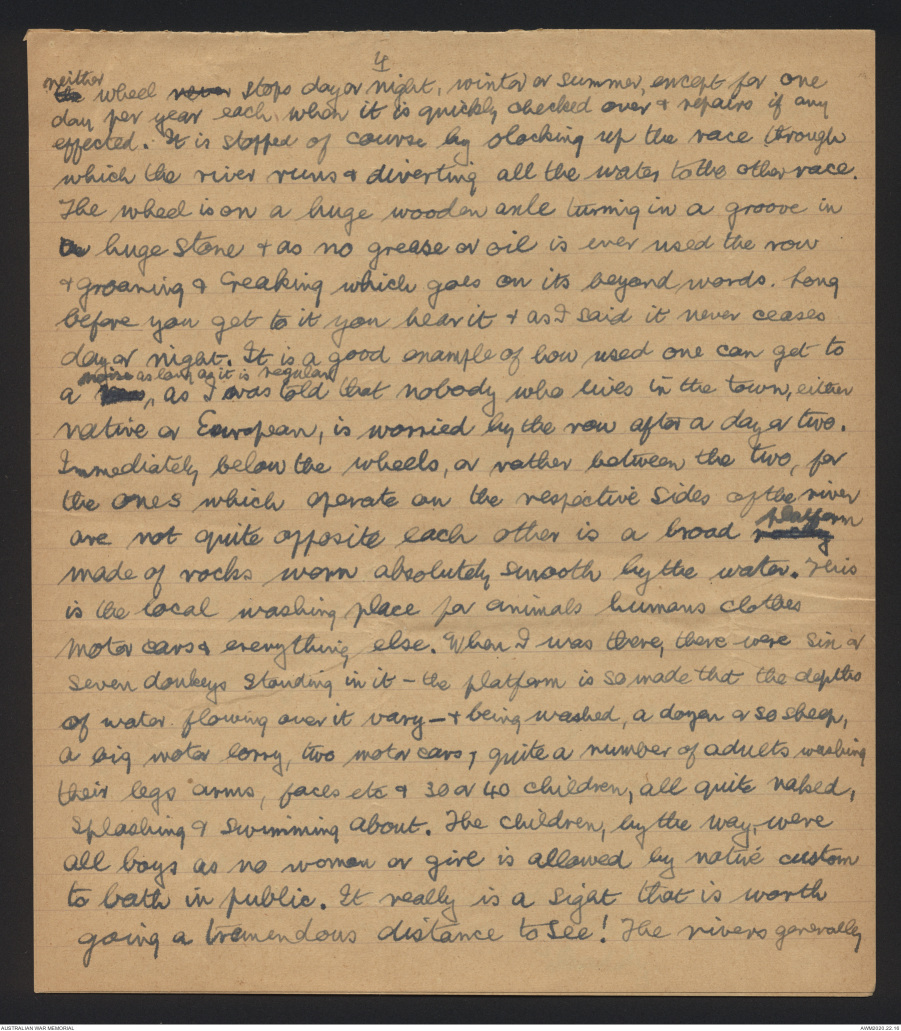
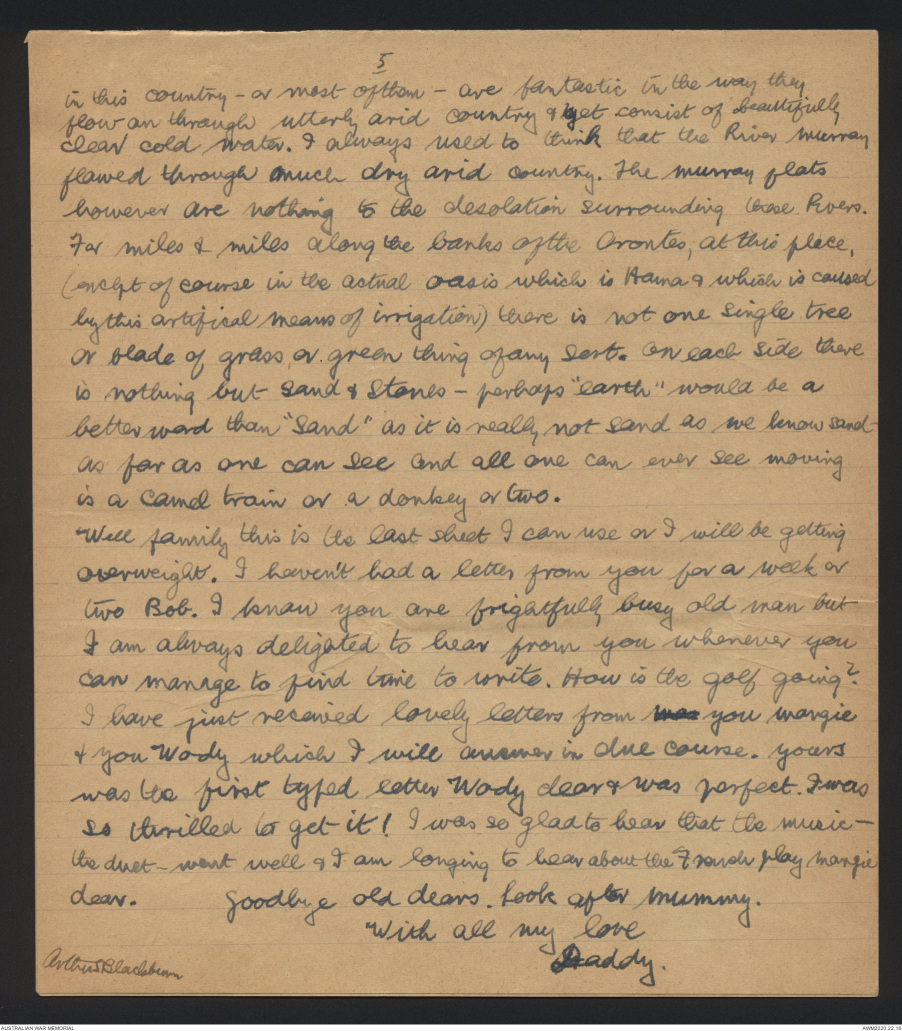
Lt Col. A.S. Blackburn
SX6962 2/3 MG Bn
AIF abroad.
15/8/41.
Dear Bob.
I hope you received the very long letter in
about six different envelopes which I sent you describing
the fighting in Syria and that the censor hasn't cut
them about too much. In last week's family letter to
Margie I told her about a visit I had paid to the market
at Aleppo. On the way down south from Aleppo I passed
through a town called HOMA Hama (Hamath of the Bible) &
there saw a remarkable water wheel or rather two of them.
The town itself, as you can imagine when you realise it is
referred to in the Bible, is very very old. It is on the banks
of the Orontes River which is a fairly swift flowing
Stream even in summer. In course of time the Orontes
has dug itself a deep & broad valley through the bare
earthern plain & the town straggles along it & partially
up the slopes of the valley on each side. An amazing
old stone bridge, alleged to be nearly as old as the town
itself spans the river. The stone is worn smooth & shiny
all over & all along the parapet from countless under years
of human beings walking over it & leaning on the
parapet to gaze out over the river. On each side
2/
of the River & running off at right angles to it through the town is
an wa aqueduct at least 40-50 feet high & sloping away from the
river until it meets the slope of the valley at an equivalent - or slightly
lower - height 100 yds or so away. It there flows into a channel
cutt along the side of the valley which thus causes a channel
of water to be running along throughout the length of the
town & on each side of it parralell to the river. The water
is raised up into the Aqueduct by means of a huge wooden
water wheel. The Aqueduct & water wheels are alleged to have
been built by the Romans - the water wheels from time to time
being repaired etc - and certainly the Aqueduct is of the
Roman style & looks old enough to be Roman. The method
of working the wheel & raising the water to the aqueduct is
as follows :- each wheel is about five feet higher than the
aqueduct & about two feet wide i.e. a section of it looking from
the side of it & not from in front of it looks like this. Each
of those squares represents a wooden box open at the top with xxxx
a sloping piece of wood, sloping outwards about two inches above
it thus. The river is then diverted by stone channels
into a narrow race a little wider than the total width
over all of the wheel & this causes the flow of the river,
already pretty strong, to become a very fierce current.
The wheel fits into this race at the bottom sufficiently
far to be covered well over the box. The pressure
of the current keeps the wheel constantly revolving
through the pressure of the current on the side of each box as
3/
it that box dips into the race & then is forced along by the current until
in the course of its circular movement it emerges in its circle out
of the water again. When under the water the box of course
naturally fills with water and is lifted up as the wheel
revolves. When over half way of course it begins to spill
a bit of the water but enough is left by the time it reaches
the top or nearly to the top - although of course it is spilling out
harder & harder the higher up on the circle made by the wheel
it gets - to send quite a lot of water out of each box running
down the sloping board to drop onto a sloping platform at the end
of the aqueduct which is so made that all water which drops
onto it runs into the channel of the aqueduct. You will realise
that each box in succession (& there must be 40 to 50 of them making up
the wheel) starts down below where it is filled with water thus
but finishes up on top the where the wheel has turned it upside
down thus. The wheel is right alongside the main -
and only - road through the town and as each box is
spilling can water all the way up, which is splashing
down the wheel into the river below & spray blowing about from
all this splashing, everyone going along the road
necessarily gets a thorough spraying of water. Primitive
as this sounds it succeeds in producing enough water to
supply the whole town - and it is a large town - with
water for its domestic needs as well as for irrigation
of gardens fruit trees vegetables etc. I am informed that
4/
neither the wheel never stops day or night, winter or summer, except for one
day per year each when it is quickly checked over & repairs if any
effected. It is stopped of course by slacking up the race through
which the river runs & diverting all the water to the other race.
The wheel is on a huge wooden axle turning in a groove in
a huge stone & as no grease or oil is ever used the row
& groaning & creaking which goes on its beyond words. Long
before you get to it you hear it & as I said it never ceases
day or night. It is a good example of how used one can get to
a noise as long as it is regular as I was told that nobody who lives in the town, either
native or European, is worried by the row after a day a two.
Immediately below the wheels, or rather between the two, for
the ones which operate on the respective sides of the river
are not quite opposite each other is a broad rocky platform
made of rocks worn absolutely smooth by the water. This
is the local washing place for animals humans clothes
motor cars & everything else. When I was there, there were six or
seven donkeys standing in it - the platform is so made that the depths
of water flowing over it vary - & being washed, a dozen or so sheep,
a big motor lorry, two motor cars, quite a number of adults washing
their legs arms, faces etc & 30 or 40 children, all quite naked,
splashing & swimming about. The children, by the way, were
all boys as no women or girl is allowed by native custom
to bath in public. It really is a sight that is worth
going a tremendous distance to see! The rivers generally
5/
in this country - or most of them - are fantastic in the way they
flow on through utterly arid country & yet consist of beautifully
clear cold water. I always used to think that the River Murray
flowed through much dry arid country. The murray flats
however are nothing to the desolation surrounding these Rivers.
For miles & miles along the banks of the Orontes, at this place,
(except of course in the actual oasis which is Hama & which is caused
by this artificial means of irrigation) there is not one single tree
or blade of grass or green thing of any sort. On each side there
is nothing but sand & stones - perhaps "earth" would be a
better word than "sand" as it is really not sand as we know sand -
as far as one can see and all one can ever see moving
is a camel train or a donkey or two.
Well family this is the last sheet I can use or I will be getting
overweight. I haven't had a letter from you for a week or
two Bob. I know you are frightfully busy old man but
I am always delighted to hear from you whenever you
can manage to find time to write. How is the golf going?
I have just received lovely letters from mar you Margie
& you Wody which I will answer in due course. Yours
was the first typed letter Wody dear & was perfect. I was
so thrilled to get it! I was so glad to hear that the music -
the duet - went well & I am longing to hear about the French play Margie
dear. Goodbye old dears. Look after mummy.
With all my love
Daddy
ArthurSBlackburn
 Jacqueline Kennedy
Jacqueline KennedyThis transcription item is now locked to you for editing. To release the lock either Save your changes or Cancel.
This lock will be automatically released after 60 minutes of inactivity.